Abstract
The cloning of the FMR1 gene enables molecular diagnosis in patients and in carriers (male and female) of this X-linked mental retardation disorder. Unlike most X-linked disorders, a considerable proportion of the female carriers of a full mutation of the FMR1 gene is affected. In this study, the intelligence quotients (IQs) were ascertained by the Wechsler Adult Intelligence Scale in 33 adult females with a full mutation, with 28 first-degree adult female relatives (mainly sisters) without a full mutation as controls. Seventy-one percent of the females with a full mutation had IQ scores below 85. In paired analysis, no significant correlation could be detected between the IQs of the females with a full mutation and those of their first-degree female relatives, reflecting a dominant effect of the FMR1 gene full mutation in the mental development of females. Considering females with a full mutation only, we observed a significant relation between the proportion of normal FMR1 alleles on the active X chromosome and IQ. We present a model to explain this relationship.
Full text
PDF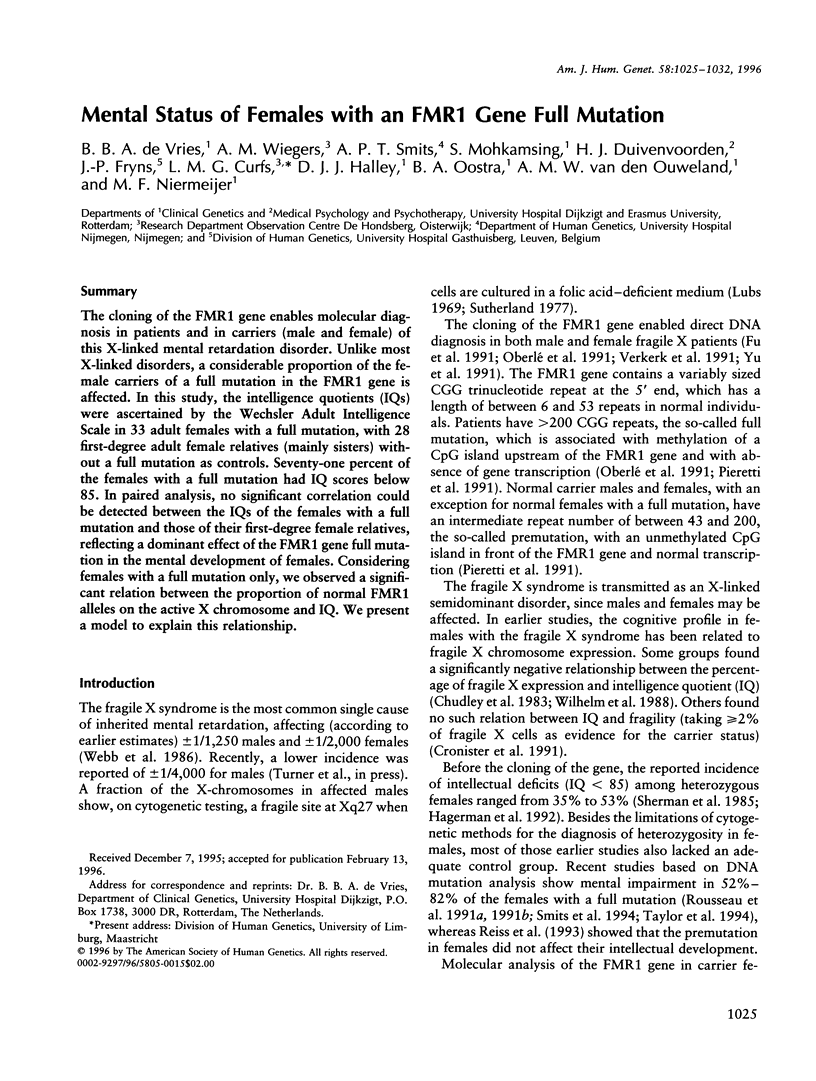
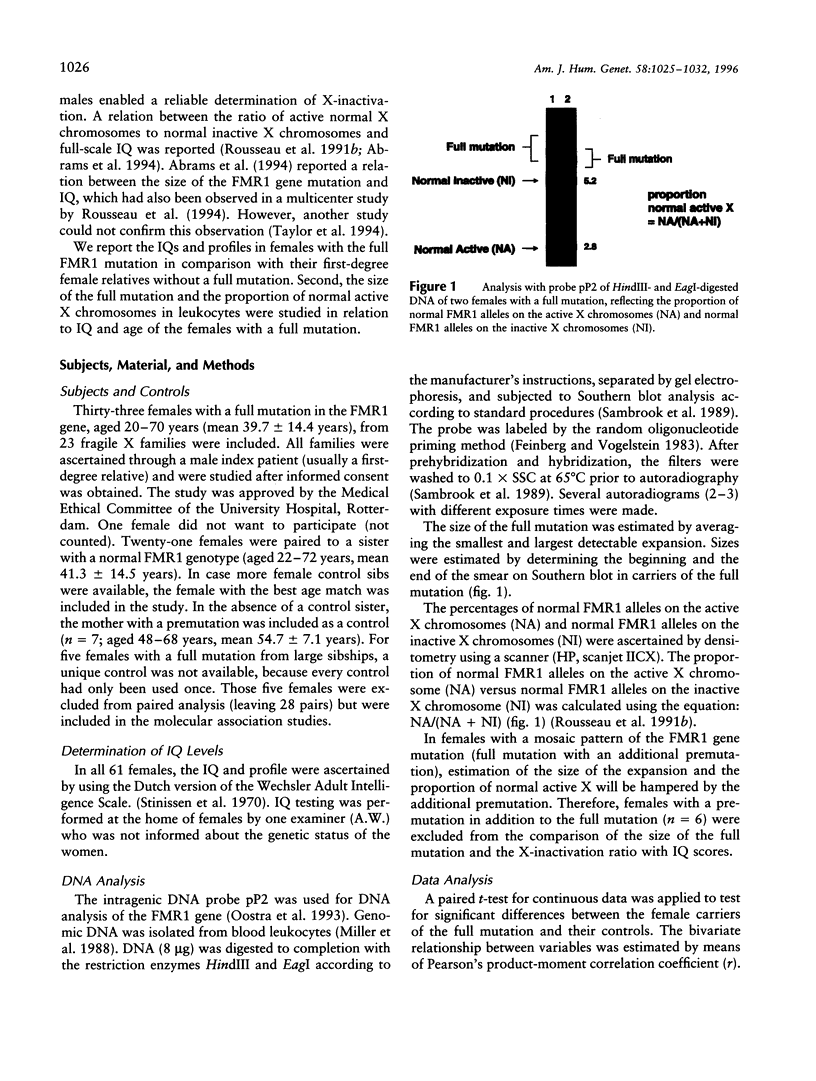
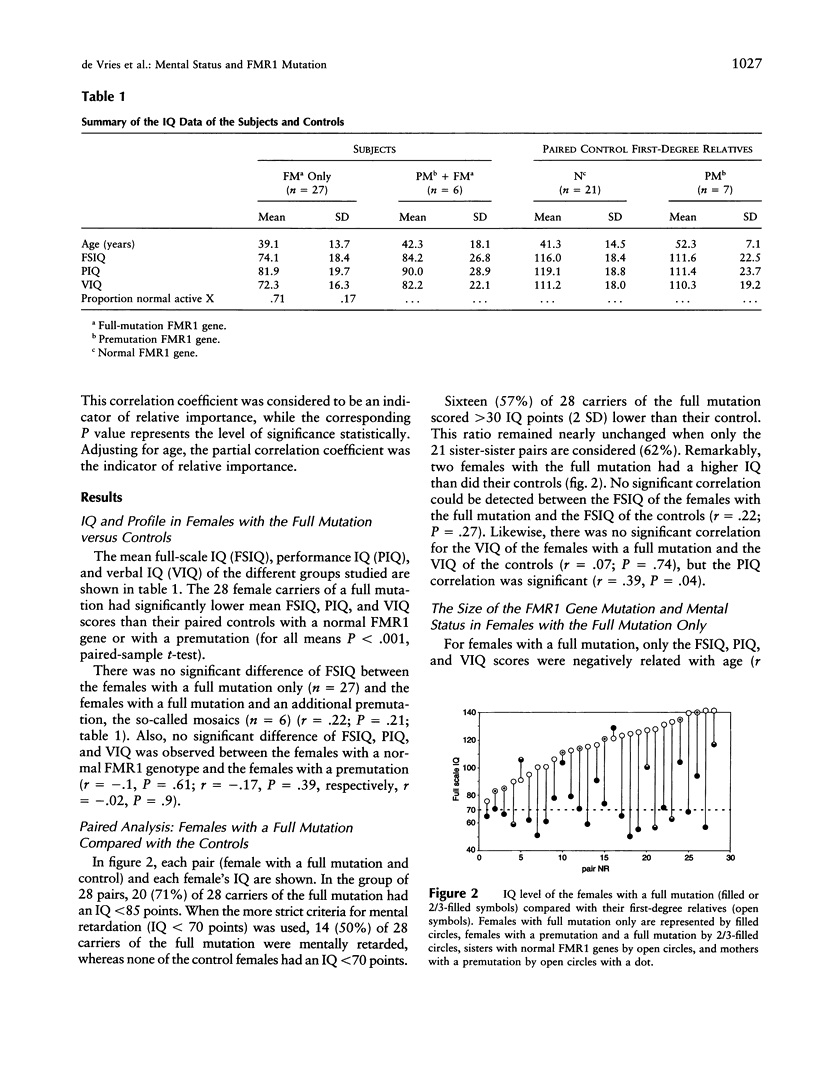
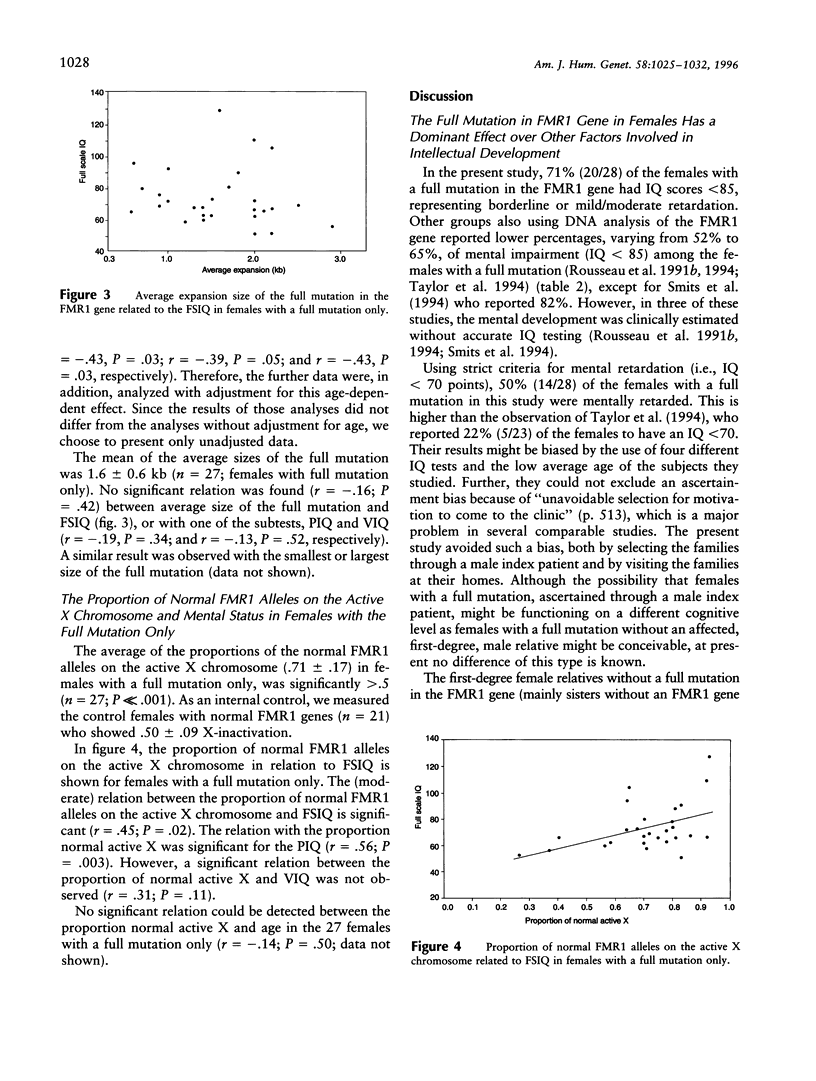
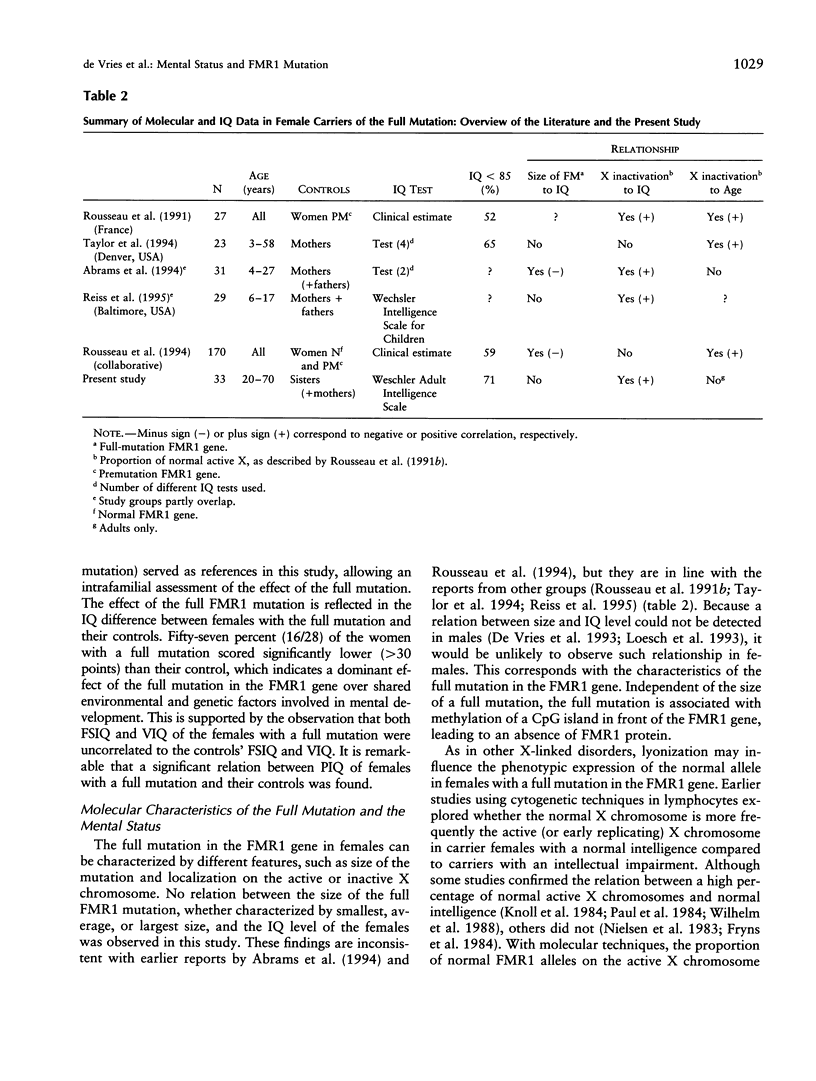
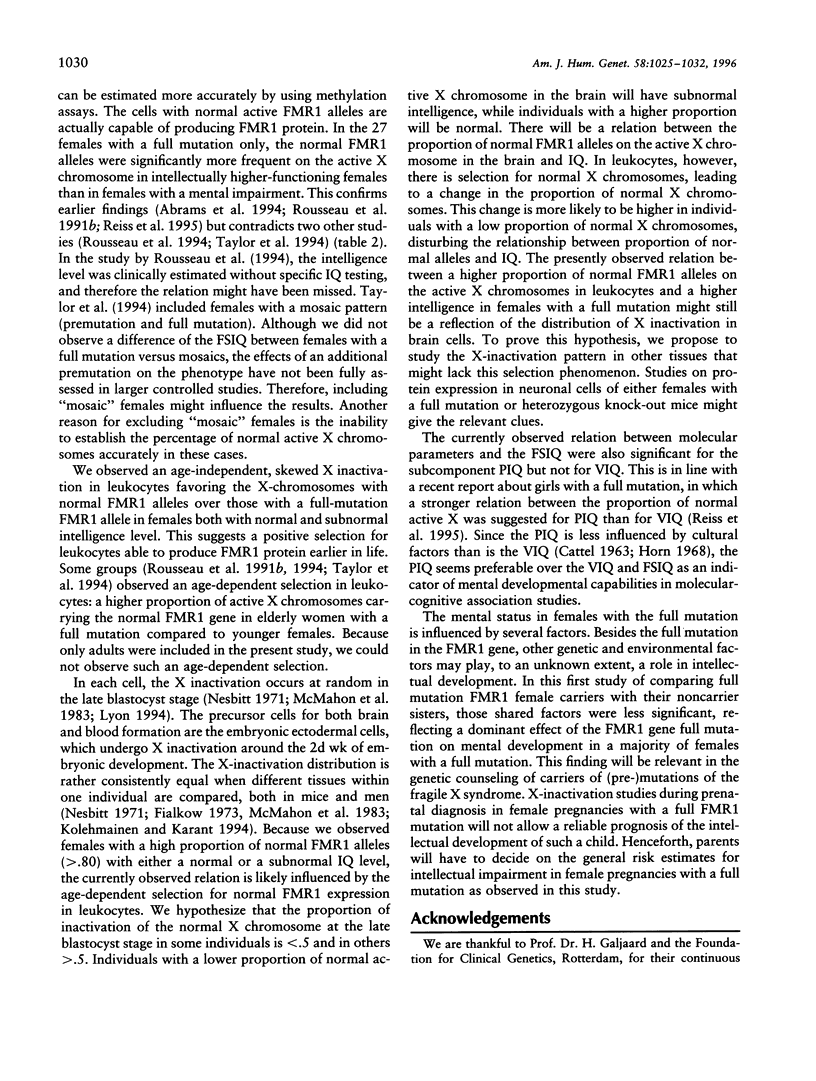
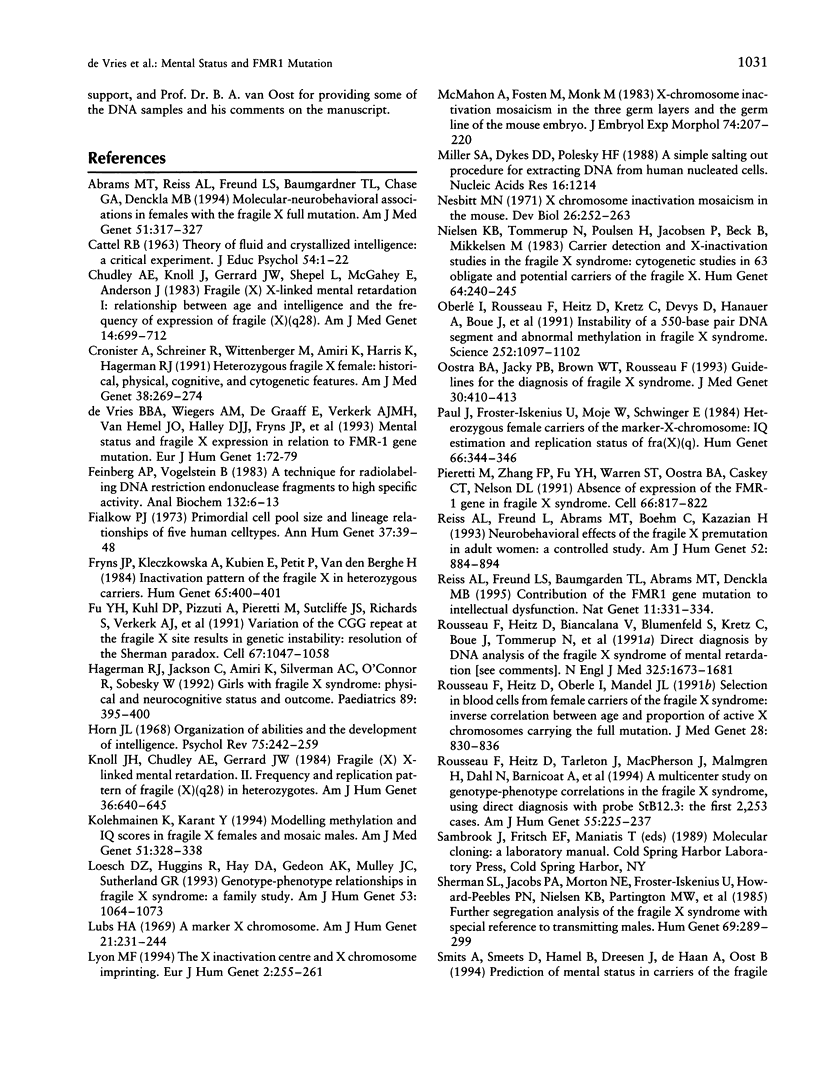
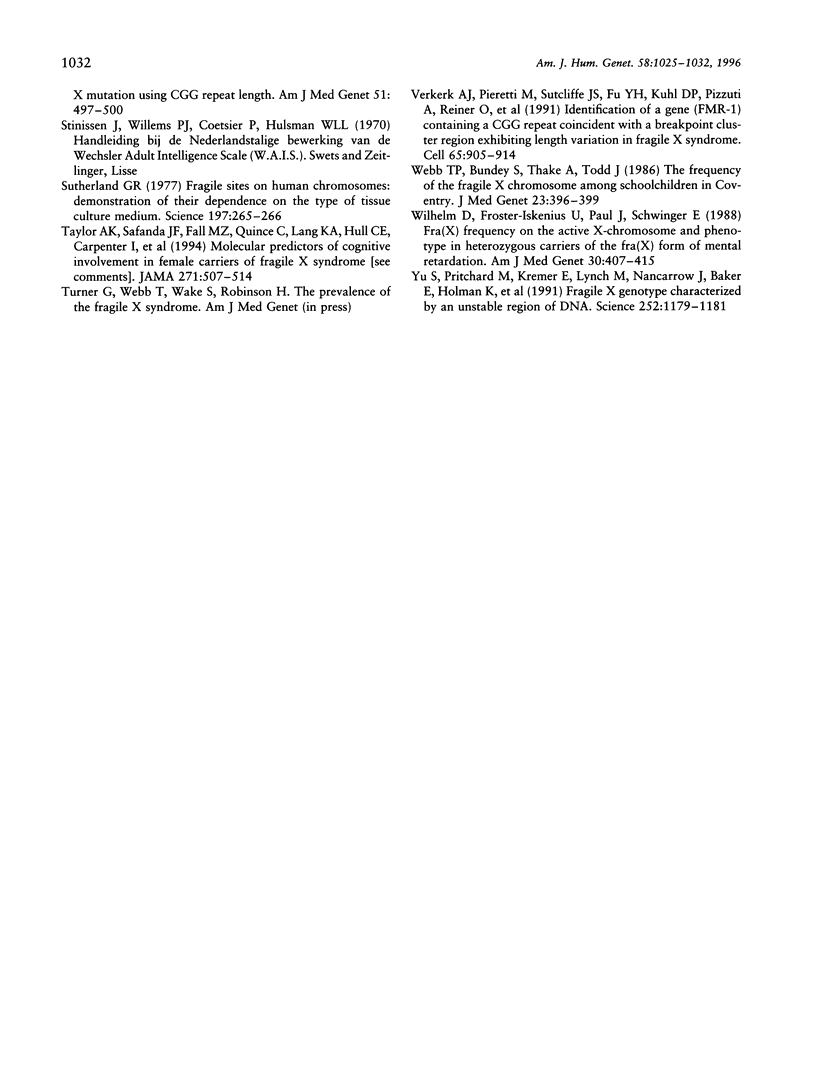
Images in this article
Selected References
These references are in PubMed. This may not be the complete list of references from this article.
- Abrams M. T., Reiss A. L., Freund L. S., Baumgardner T. L., Chase G. A., Denckla M. B. Molecular-neurobehavioral associations in females with the fragile X full mutation. Am J Med Genet. 1994 Jul 15;51(4):317–327. doi: 10.1002/ajmg.1320510407. [DOI] [PubMed] [Google Scholar]
- Chudley A. E., Knoll J., Gerrard J. W., Shepel L., McGahey E., Anderson J. Fragile (X) X-linked mental retardation I: relationship between age and intelligence and the frequency of expression of fragil (X)(q28). Am J Med Genet. 1983 Apr;14(4):699–712. doi: 10.1002/ajmg.1320140412. [DOI] [PubMed] [Google Scholar]
- Cronister A., Schreiner R., Wittenberger M., Amiri K., Harris K., Hagerman R. J. Heterozygous fragile X female: historical, physical, cognitive, and cytogenetic features. Am J Med Genet. 1991 Feb-Mar;38(2-3):269–274. doi: 10.1002/ajmg.1320380221. [DOI] [PubMed] [Google Scholar]
- Feinberg A. P., Vogelstein B. A technique for radiolabeling DNA restriction endonuclease fragments to high specific activity. Anal Biochem. 1983 Jul 1;132(1):6–13. doi: 10.1016/0003-2697(83)90418-9. [DOI] [PubMed] [Google Scholar]
- Fialkow P. J. Primordial cell pool size and lineage relationships of five human cell types. Ann Hum Genet. 1973 Jul;37(1):39–48. doi: 10.1111/j.1469-1809.1973.tb01813.x. [DOI] [PubMed] [Google Scholar]
- Fryns J. P., Kleczkowska A., Kubień E., Petit P., Van den Berghe H. Inactivation pattern of the fragile X in heterozygous carriers. Hum Genet. 1984;65(4):400–401. doi: 10.1007/BF00291567. [DOI] [PubMed] [Google Scholar]
- Fu Y. H., Kuhl D. P., Pizzuti A., Pieretti M., Sutcliffe J. S., Richards S., Verkerk A. J., Holden J. J., Fenwick R. G., Jr, Warren S. T. Variation of the CGG repeat at the fragile X site results in genetic instability: resolution of the Sherman paradox. Cell. 1991 Dec 20;67(6):1047–1058. doi: 10.1016/0092-8674(91)90283-5. [DOI] [PubMed] [Google Scholar]
- Hagerman R. J., Jackson C., Amiri K., Silverman A. C., O'Connor R., Sobesky W. Girls with fragile X syndrome: physical and neurocognitive status and outcome. Pediatrics. 1992 Mar;89(3):395–400. [PubMed] [Google Scholar]
- Horn J. L. Organization of abilities and the development of intelligence. Psychol Rev. 1968 May;75(3):242–259. doi: 10.1037/h0025662. [DOI] [PubMed] [Google Scholar]
- Knoll J. H., Chudley A. E., Gerrard J. W. Fragile (X) X-linked mental retardation. II. Frequency and replication pattern of fragile (X)(q28) in heterozygotes. Am J Hum Genet. 1984 May;36(3):640–645. [PMC free article] [PubMed] [Google Scholar]
- Kolehmainen K., Karant Y. Modeling methylation and IQ scores in fragile X females and mosaic males. Am J Med Genet. 1994 Jul 15;51(4):328–338. doi: 10.1002/ajmg.1320510408. [DOI] [PubMed] [Google Scholar]
- Loesch D. Z., Huggins R., Hay D. A., Gedeon A. K., Mulley J. C., Sutherland G. R. Genotype-phenotype relationships in fragile X syndrome: a family study. Am J Hum Genet. 1993 Nov;53(5):1064–1073. [PMC free article] [PubMed] [Google Scholar]
- Lubs H. A. A marker X chromosome. Am J Hum Genet. 1969 May;21(3):231–244. [PMC free article] [PubMed] [Google Scholar]
- Lyon M. F. The X inactivation centre and X chromosome imprinting. Eur J Hum Genet. 1994;2(4):255–261. doi: 10.1159/000472369. [DOI] [PubMed] [Google Scholar]
- McMahon A., Fosten M., Monk M. X-chromosome inactivation mosaicism in the three germ layers and the germ line of the mouse embryo. J Embryol Exp Morphol. 1983 Apr;74:207–220. [PubMed] [Google Scholar]
- Nesbit M. N. X chromosome inactivation mosaicism in the mouse. Dev Biol. 1971 Oct;26(2):252–263. doi: 10.1016/0012-1606(71)90125-4. [DOI] [PubMed] [Google Scholar]
- Nielsen K. B., Tommerup N., Poulsen H., Jacobsen P., Beck B., Mikkelsen M. Carrier detection and X-inactivation studies in the fragile X syndrome. Cytogenetic studies in 63 obligate and potential carriers of the fragile X. Hum Genet. 1983;64(3):240–245. doi: 10.1007/BF00279401. [DOI] [PubMed] [Google Scholar]
- Oostra B. A., Jacky P. B., Brown W. T., Rousseau F. Guidelines for the diagnosis of fragile X syndrome. National Fragile X Foundation. J Med Genet. 1993 May;30(5):410–413. doi: 10.1136/jmg.30.5.410. [DOI] [PMC free article] [PubMed] [Google Scholar]
- Paul J., Froster-Iskenius U., Moje W., Schwinger E. Heterozygous female carriers of the marker-X-chromosome: IQ estimation and replication status of fra(X)(q). Hum Genet. 1984;66(4):344–346. doi: 10.1007/BF00287638. [DOI] [PubMed] [Google Scholar]
- Pieretti M., Zhang F. P., Fu Y. H., Warren S. T., Oostra B. A., Caskey C. T., Nelson D. L. Absence of expression of the FMR-1 gene in fragile X syndrome. Cell. 1991 Aug 23;66(4):817–822. doi: 10.1016/0092-8674(91)90125-i. [DOI] [PubMed] [Google Scholar]
- Reiss A. L., Freund L. S., Baumgardner T. L., Abrams M. T., Denckla M. B. Contribution of the FMR1 gene mutation to human intellectual dysfunction. Nat Genet. 1995 Nov;11(3):331–334. doi: 10.1038/ng1195-331. [DOI] [PubMed] [Google Scholar]
- Reiss A. L., Freund L., Abrams M. T., Boehm C., Kazazian H. Neurobehavioral effects of the fragile X premutation in adult women: a controlled study. Am J Hum Genet. 1993 May;52(5):884–894. [PMC free article] [PubMed] [Google Scholar]
- Rousseau F., Heitz D., Biancalana V., Blumenfeld S., Kretz C., Boué J., Tommerup N., Van Der Hagen C., DeLozier-Blanchet C., Croquette M. F. Direct diagnosis by DNA analysis of the fragile X syndrome of mental retardation. N Engl J Med. 1991 Dec 12;325(24):1673–1681. doi: 10.1056/NEJM199112123252401. [DOI] [PubMed] [Google Scholar]
- Rousseau F., Heitz D., Oberlé I., Mandel J. L. Selection in blood cells from female carriers of the fragile X syndrome: inverse correlation between age and proportion of active X chromosomes carrying the full mutation. J Med Genet. 1991 Dec;28(12):830–836. doi: 10.1136/jmg.28.12.830. [DOI] [PMC free article] [PubMed] [Google Scholar]
- Rousseau F., Heitz D., Tarleton J., MacPherson J., Malmgren H., Dahl N., Barnicoat A., Mathew C., Mornet E., Tejada I. A multicenter study on genotype-phenotype correlations in the fragile X syndrome, using direct diagnosis with probe StB12.3: the first 2,253 cases. Am J Hum Genet. 1994 Aug;55(2):225–237. [PMC free article] [PubMed] [Google Scholar]
- Sherman S. L., Jacobs P. A., Morton N. E., Froster-Iskenius U., Howard-Peebles P. N., Nielsen K. B., Partington M. W., Sutherland G. R., Turner G., Watson M. Further segregation analysis of the fragile X syndrome with special reference to transmitting males. Hum Genet. 1985;69(4):289–299. doi: 10.1007/BF00291644. [DOI] [PubMed] [Google Scholar]
- Sutherland G. R. Fragile sites on human chromosomes: demonstration of their dependence on the type of tissue culture medium. Science. 1977 Jul 15;197(4300):265–266. doi: 10.1126/science.877551. [DOI] [PubMed] [Google Scholar]
- Taylor A. K., Safanda J. F., Fall M. Z., Quince C., Lang K. A., Hull C. E., Carpenter I., Staley L. W., Hagerman R. J. Molecular predictors of cognitive involvement in female carriers of fragile X syndrome. JAMA. 1994 Feb 16;271(7):507–514. [PubMed] [Google Scholar]
- Verkerk A. J., Pieretti M., Sutcliffe J. S., Fu Y. H., Kuhl D. P., Pizzuti A., Reiner O., Richards S., Victoria M. F., Zhang F. P. Identification of a gene (FMR-1) containing a CGG repeat coincident with a breakpoint cluster region exhibiting length variation in fragile X syndrome. Cell. 1991 May 31;65(5):905–914. doi: 10.1016/0092-8674(91)90397-h. [DOI] [PubMed] [Google Scholar]
- Webb T. P., Bundey S., Thake A., Todd J. The frequency of the fragile X chromosome among schoolchildren in Coventry. J Med Genet. 1986 Oct;23(5):396–399. doi: 10.1136/jmg.23.5.396. [DOI] [PMC free article] [PubMed] [Google Scholar]
- Wilhelm D., Froster-Iskenius U., Paul J., Schwinger E. Fra(X) frequency on the active X-chromosome and phenotype in heterozygous carriers of the fra(X) form of mental retardation. Am J Med Genet. 1988 May-Jun;30(1-2):407–415. doi: 10.1002/ajmg.1320300141. [DOI] [PubMed] [Google Scholar]
- Yu S., Pritchard M., Kremer E., Lynch M., Nancarrow J., Baker E., Holman K., Mulley J. C., Warren S. T., Schlessinger D. Fragile X genotype characterized by an unstable region of DNA. Science. 1991 May 24;252(5009):1179–1181. doi: 10.1126/science.252.5009.1179. [DOI] [PubMed] [Google Scholar]
- Zavodny P. J., Petro M. E., Kumar C. C., Dailey S. H., Lonial H. K., Narula S. K., Leibowitz P. J. The nucleotide sequence of chicken smooth muscle myosin light chain two. Nucleic Acids Res. 1988 Feb 11;16(3):1214–1214. doi: 10.1093/nar/16.3.1214. [DOI] [PMC free article] [PubMed] [Google Scholar]
- de Vries B. B., Wiegers A. M., de Graaff E., Verkerk A. J., Van Hemel J. O., Halley D. J., Fryns J. P., Curfs L. M., Niermeijer M. F., Oostra B. A. Mental status and fragile X expression in relation to FMR-1 gene mutation. Eur J Hum Genet. 1993;1(1):72–79. doi: 10.1159/000472389. [DOI] [PubMed] [Google Scholar]



